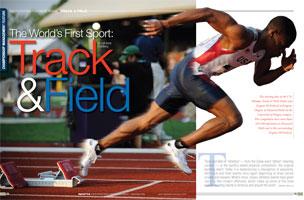
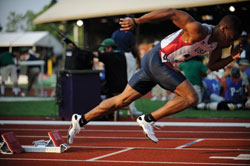 Track and field or "athletics" - from the Greek word "athlos" meaning contest - is the world's oldest physical competition, the original sporting event. Today it is experiencing a resurgence of popularity, with track and field events once again beginning to draw record crowds and viewers. What's more, classic athletics events have given rise to a few modern offshoots, which make up some of the most popular sporting events in America and around the world.
Track and field or "athletics" - from the Greek word "athlos" meaning contest - is the world's oldest physical competition, the original sporting event. Today it is experiencing a resurgence of popularity, with track and field events once again beginning to draw record crowds and viewers. What's more, classic athletics events have given rise to a few modern offshoots, which make up some of the most popular sporting events in America and around the world.
Three Thousand Years of Athletics
Track and field events have evolved over the thousands of years since the Greeks invented athletics with the first Olympics. The earliest recorded appearance of the sport was in 776 B.C., when the only event was a stadium-length footrace.
During the following millenniums, a number of different running, jumping and throwing contests emerged and became part of the overall track and field event. Today, track and field events include some combination of the following:
Track events: 100, 200, 400, 800, 1500, 5,000/10,000 meters; mile; 100, 110 and 400 meter hurdles; 3000 meter steeplechase; marathon; 4 x 100 and 4 x 400 relays
Field events: high jump, long jump, triple jump, pole vault, shot put, discus throw, javelin throw, hammer throw
Decathlon: four track and six field events held on two consecutive days in this sequence: 100m, long jump, shot, high jump,400m, 110m hurdles, discus, pole vault, javelin and 1500m.
Heptathlon: a two-day contest consisting of 100m hurdles, shot, high jump, 200m; second day: long jump, javelin and 800m.
 Beyond these classic track and field events, athletics inspired the birth of several new running sports and events, such as cross country, marathon running and mountain and trail running, which have become a huge part of track and field participation.
Beyond these classic track and field events, athletics inspired the birth of several new running sports and events, such as cross country, marathon running and mountain and trail running, which have become a huge part of track and field participation.
Track and Field Today
After struggling with drug-use controversies over the past decade, track and field made a significant comeback during the 2008 Olympics. Several mind-blowing performances, particularly by Jamaica's Usain Bolt, put track and field squarely back in the public spotlight.
Team USA also celebrated several victories, including seven gold, nine silver and seven bronze medals. And if participation by young track and field hopefuls is any indication, Team USA has a bright Olympic future ahead of it as well. According to USA Track & Field (USATF), the National Governing Body for track and field, long-distance running and race walking, athletics are the number-one high school and junior high school participatory sport in America.
USATF's motto is to make track a field "a sport for everyone, for life," and they accomplish that with a variety of initiatives: developing grassroots events, such as the Junior Olympics, that create increased interest in the sport and develop future Olympians; promoting training and competition programs for athletes of all ages; and sanctioning more than4,000 events each year.
Track and field also has an international governing body, the International Association of Athletics Federations, which regulates timing methods, maintains world records and organizes numerous events, such as the World Championships in Athletics.
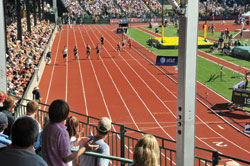 Hitting the Track
Hitting the Track
For track and field athletes, opportunities to compete abound. USATF has 57 associations that organize local, statewide and regional competition and training events across America. The USATF Junior Olympics, held during the last week of July, brings together more than 6,000 of America's next-generation athletics stars annually. USATF also hosts Junior Olympics in cross country, as well as national championships in track and field, cross country and race walking.
Beyond USATF, a number of other national, regional and state organizations create track and field and running events throughout the country and world. The Amateur Athletic Union (AAU), for example, hosts hundreds of track and field events each year through its local, state and regional clubs, as well as national championships and the Junior Olympics. And the Road Runners Club of America (RRCA) promotes recreational running with running clubs in every state and local, regional and national events.
Time and Place
Once an outdoor sport popular during warmer months, athletics competitions today occur nearly year-round. While running events are less common in the winter months, cold weather running certainly has a following.
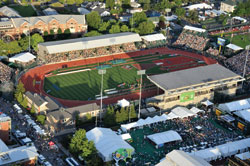 Marathons and other winter running events most commonly occur in states with relatively warm climates, such as the Callaway Gardens Marathon in Pine Mountain, Georgia in January and the New Orleans Mardi Gras Marathon in February. But never underestimate the passion of runners, let alone their desire for the next big challenge, even in the coldest months and the coldest places. The Moose Mountain Snowshoe Challenge in Fairbanks, Alaska, offers a 5K and 8K race, which competitors literally run in snowshoes. This year's Challenge, held January 12, saw athletes ages 19 to over 60 running in negative 12 degree temperatures.
Marathons and other winter running events most commonly occur in states with relatively warm climates, such as the Callaway Gardens Marathon in Pine Mountain, Georgia in January and the New Orleans Mardi Gras Marathon in February. But never underestimate the passion of runners, let alone their desire for the next big challenge, even in the coldest months and the coldest places. The Moose Mountain Snowshoe Challenge in Fairbanks, Alaska, offers a 5K and 8K race, which competitors literally run in snowshoes. This year's Challenge, held January 12, saw athletes ages 19 to over 60 running in negative 12 degree temperatures.
USATF has established regulations for both indoor and outdoor track and field facilities, which form the standard for most facilities and events. The organization also certifies road and trail racing courses to ensure accurate distances.
Indoor Events
Today, track and field athletes have a new way to make a living at the sport they love and potential new fans have a chance to see world-class athletes at work. The Visa Championship Series is a series of nationally televised USATF competitions featuring Team USA's best track and field athletes.
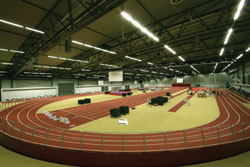 The Visa Championship Series has two seasons, indoor in the winter and outdoor in the spring and summer. According to organizers, the Indoor Series averages more than 10,000 fans per meet, while the Outdoor Series meets are standing-room only. Athletes compete for prize money at each meet, and the top athletes share in a bonus pool of $100,000 to help them on their Olympic journey.
The Visa Championship Series has two seasons, indoor in the winter and outdoor in the spring and summer. According to organizers, the Indoor Series averages more than 10,000 fans per meet, while the Outdoor Series meets are standing-room only. Athletes compete for prize money at each meet, and the top athletes share in a bonus pool of $100,000 to help them on their Olympic journey.
Fayetteville, Arkansas is the third stop on the Visa Championships Indoor Series trail. Hosted at the Randall Tyson Track Center at the University of Arkansas, the Tyson Invitational, now in its 10th year, is one of Fayetteville's hardest tickets to get. Event sponsor Tyson Foods offers a special extra incentive to competitors with a $50,000 bonus to any individual or group who breaks a world record.
Calling itself "The Track Capital of the World," Fayetteville has a long-standing tradition of track and field excellence with 42 national championships won by the University of Arkansas Razorbacks. The track and field passion has carried over into other areas of Fayetteville life as well.
"We have a lot of former athletes here who have stuck around, which means we have a huge volunteer base and lots of fans," said Ryan Grigsby, sports marketing manager for the Fayetteville Visitor Bureau. "Also, our hotels and their staff are very knowledgeable about the track athlete, what their needs are and how to treat teams."
Outdoor Events Fayetteville has competition for the title of track and field's capital. Eugene, Oregon has its own nickname, "Track Town U.S.A." Home of Nike and the University of Oregon, Eugene has its own long and distinguished record in track and field as well as a place in running history.
Fayetteville has competition for the title of track and field's capital. Eugene, Oregon has its own nickname, "Track Town U.S.A." Home of Nike and the University of Oregon, Eugene has its own long and distinguished record in track and field as well as a place in running history.
The University of Oregon began its track and field program in 1895. The University became home to a series of famed track and field coaches, including Bill Hayward, who began the school's athletics ascension; Bill Bowerman, who mentored countless Olympians and All-Americans, such as Steve Prefontaine; cross country coach Bill Dellinger and champion of women's athletics, Tom Heinonen.
Central to Track Town U.S.A.'s legacy and future in the sport is the University of Oregon's Hayward Field. The 10,500-person stadium received a variety of state-of-the-art updates in 2008, including a new track surface, permanent lights, a video board and newly configured infield.
Hayward Field has hosted four Olympic Trials, most recently in 2008, and is slated to host them again in 2012. Scores of other championships, among them NCAA, Pacific 10 and AAU events, have also found a home under Hayward Field's unique covered grandstands.
"The last time we hosted the Olympic Trials was in 1980, so it was such an amazing coup to get it back,"said Janis Ross, vice president of convention & sports marketing for the Convention & Visitors Association of Lane County Oregon. "When we won the bid, we expressed that we wanted it to be an athlete-focused and friendly event. In the end, it even surpassed our imaginations."
While not claiming to be the center of the track and field universe, the University of Wisconsin at Oshkosh is certainly holding its own as a preeminent track and field destination as well.
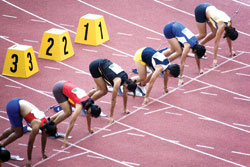 J.J. Keller Field at Titan Stadium is a 10,000-person stadium overlooking a 9-lane track and a field that can accommodate 1,000 people. The track's lanes boast an extra-wide 48 inches as well as a Mondo surface. The official supplier of track surfaces to the last 10 Olympic Games, Mondo has been the surface for200 world records.
J.J. Keller Field at Titan Stadium is a 10,000-person stadium overlooking a 9-lane track and a field that can accommodate 1,000 people. The track's lanes boast an extra-wide 48 inches as well as a Mondo surface. The official supplier of track surfaces to the last 10 Olympic Games, Mondo has been the surface for200 world records.
J.J. Keller Field has a variety of other crucial perks that can help create a standout event.
"Our practice track is only about 25 yards away from the stadium, so athletes can warm up and practice nearby," said Allen Ackerman, athletic director at the University of Wisconsin Oshkosh."We also have areas for hospitality rooms, indoor warm up rooms for athletes and a very large press box."
J.J. Keller Field is just one part of the Oshkosh Sports Complex Capital Campaign, a project that built the university's premiere multi-sport facility, which aims to host 90 university and community events a year and generate up to $25 million in tourism revenue.
The Sweet Side of Track and Field
Thirty years ago the Hershey Company created the Hershey's Track & Field program to promote youth physical fitness and provide fun learning experiences for children 9 to 14 years old. Today, it is the largest youth sports program of its kind in the United States and Canada.
Hershey's Track & Field hosts local, district, state and provincial track and field meets, with five finalists from each state or province going on to participate in the Hershey's North American Finals Meet in Hershey's hometown.
Hershey, Pennsylvania and its surrounding counties have eight track and field facilities, all constructed within the last five years, all with the latest track specifications. But the Hershey's North American Finals take place at a particularly special venue, the Henry Hershey Field at Milton Hershey High School.
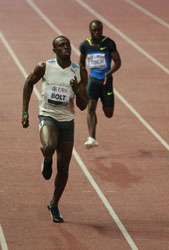 The Milton Hershey School, originally a home and school for orphans, is the legacy of chocolate magnate Milton Hershey and his wife Catherine. Today, the school is home to more than 1,700 under served or low-income children. As part of the Hersheys' vision, the school's students have access to exceptional teachers, opportunities and facilities, and Henry Hershey Stadium is no exception.
The Milton Hershey School, originally a home and school for orphans, is the legacy of chocolate magnate Milton Hershey and his wife Catherine. Today, the school is home to more than 1,700 under served or low-income children. As part of the Hersheys' vision, the school's students have access to exceptional teachers, opportunities and facilities, and Henry Hershey Stadium is no exception.
"It's literally like a small college campus," explained Gregg Cook, sports marketing manager for the Hershey Harrisburg Regional Visitors Bureau. "The track facility is tremendous, and the school provides the perfect setting for it."
A Distinguished History, A Bright Future
The 2008 track and field Olympic trials earned better television ratings than even Wimbledon, and even more Americans tuned in to watch Team USA fight for the gold in Beijing.
USATF recently announced a new goal: to elevate track and field from a passionate following during every Olympic game to a year-round, lifelong favorite for Americans. Judging by the recent increase in interest, it seems the organization is well on its way to that goal. And given the wealth of track and field friendly communities and the investments they've made in world-class facilities, all of the elements are clearly in place to return the sport to its preeminent classic status as the world's first and favorite sport.

